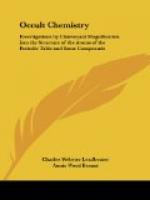III AND IIIa.—THE CUBE GROUPS.
We have here four groups to consider, all the members of which are triads, and have six funnels, opening on the six faces of a cube.
III.—Boron, scandium and yttrium were examined; they are all triatomic, paramagnetic, and positive. The corresponding group consists of nitrogen, vanadium and niobium; they are triatomic, paramagnetic, and negative. We have not examined the remaining members of these groups. In these two groups nitrogen dominates, and in order to make the comparison easy the nitrogen elements are figured on both Plate XI and Plate XII. It will be seen that scandium and yttrium, of the positive group, differ only in details from vanadium and niobium, of the negative group; the ground-plan on which they are built is the same. We noted a similar close resemblance between the positive strontium and the negative molybdenum.
[Illustration: PLATE XI.]
BORON (Plate III, 4, and Plate XI, 1). We have here the simplest form of the cube; the funnels contain only five bodies—four six-atomed ovoids and one six-atomed “cigar.” The central globe has but four five-atomed spheres. It is as simple in relation to its congeners as is beryllium to its group-members.
BORON: 6 funnels of 30 atoms 180
Central
globe 20
——
Total
200
——
Atomic weight
10.86
Number weight
200/18 11.11
SCANDIUM (Plate XI, 2). For the first time we
meet funnels of different
types, A and B, three of each kind; A appear to be
positive and B negative,
but this must be stated with reserve.
In A the boron funnel is reproduced, the “cigar” having risen above its companion ovoids; but the most important matter to note in respect to this funnel is our introduction to the body marked a 110. This body was observed by us first in nitrogen, in 1895, and we gave it the name of the “nitrogen balloon,” for in nitrogen it takes the balloon form, which it also often assumes in other gaseous elements. Here it appears as a sphere—the form always assumed on the proto level—and it will be seen, on reference to the detailed diagram 4 a, to be a complicated body, consisting of six fourteen-atomed globes arranged round a long ovoid containing spheres with three, four, six, six, four, three, atoms respectively. It will be observed that this balloon appears in every member of these two groups, except boron.
The B funnel runs largely to triads, c and b, b (see 4 b) having not only a triadic arrangement of spheres within its contained globes, but each sphere has also a triplet of atoms. In c (see 4 c) there is a triadic arrangement of spheres, but each contains duads. B is completed by a five-atomed sphere at the top of the funnel. It should be noted that a, b and c all are constituents of nitrogen.




